 |
48 (10) (1996), pp. 12-14. JOM is a publication of The Minerals, Metals & Materials Society |
|---|
 |
48 (10) (1996), pp. 12-14. JOM is a publication of The Minerals, Metals & Materials Society |
|---|
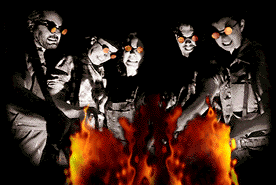 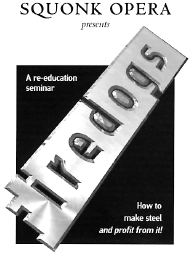 |
Boasting a direct bloodline from steelworkers, members of Squonk were looking for an interesting story to stage and decided to look no further than the smokestacks of the abandoned steel mills visible through their apartment windows in Pittsburgh. The end result was "Firedogs," which transports the audience through the history of steelmaking from the original fondue-eating caveman to the Homestead steel strike of the Andrew Carnegie era and to the current day. Along the way, the audience meets some strange-looking, yet hauntingly familiar, characters—Bessie the Bessemer Furnace, Old Man Steel, and the Five Impurities, to name a few—who reiterate the steelmaking process from lumps to forming.
| QuickTime Clips from "Firedogs" |
|---|
The Recipe for Steel (~2.4M)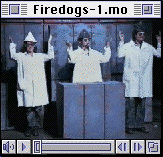
|
Percussion Pig Iron (~1.1M)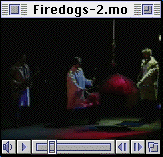
|
Blastdance (~2.7M)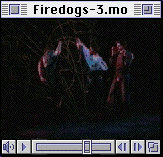
|
Forming Old Man Steel (~1.6M)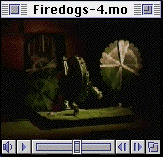
|
| Exclusively prepared for JOM, these clips were extracted from a video made by Squonk Opera during an actual performace of the play. Click on an image to download the QuickTime file (8 frames per second, 24 bit color, Cinpak codic compression at 100% quality, 11 kHz audio). The clips were prepared by Joe Hager. |
The first half of show is concerned with the steelmaking process. The "production docket" begins by tracing the beginnings of steel as three mad scientists (Figure 1) stir and mix a concoction of molten iron, which looks enticingly like a rich fondue to a caveman wandering by. Pig iron descends onto the stage as a pig, only to be cut open by the curious scientists to display its molecules (Figure 2). The Squonk team then accosts an unwilling Old Man Steel to show the difference between steel composition and pig iron composition (Figure 3).
What follows is "Blastdance," an enticing spoof on the 1980s movie Flashdance. In the dance (choreographed by Tome Cousin), the Five Impurities (carbon, sulfur, phosphorus, silicon, and manganese), portrayed by Squonks as bug-eyed characters wearing clouds of excited electrons, are lured away in a seductive dance by Losey's oxygen molecule (Figure 4).
"Safety first," comments Old Man Steel early in the show, and the announcer reinforces the message as Squonks dress a worker in a safety suit for work near the Bessemer furnace (Figure 5). As the announcer reads a highly detailed account of how steel is heated in the Bessemer furnace, Dempsey appears on stage outfitted as the furnace to illustrate the process (Figure 6). Eventually, the inevitable happens, and the hapless worker wanders too close to the furnace and is injured.
The worker's mishap cues the entrance of the forming machines who illustrate the processes of forging, rolling, and drawing on Old Man Steel (Figure 7). Once again, a great amount of detail has been incorporated into the script as the announcer describes the pressures required for forging and compares the processes to more common processes.
The parade of steel ends the first act. In a satire on the basket passing at evangelical church revivals, Old Man Steel urges the audience to "all hail King Steel," and baskets are passed among the crowd for steel donations of lamps, bowling trophies, watches, and other steel items.
The lightheartedness ends with the start of the second half, however, as Squonk Opera turns from the process to the processors. Men become the machines to the "mechanized rhythm of mass production" as the darkness of the stage lends a dramatic Orwellian flavor to the tightly choreographed Hammer Dance performed in front of the backdrop of a giant ant (Figure 8).
In one of the more abstract segments of the show, a surreal interpretation of the Homestead strike is included. As Andrew Carnegie fishes on one side of the stage, Pinkerton's puppet police travel down the river toward the strikers through the use of a boat-like hat on the head of Losey (Figure 9). As Losey sings about the plight of immigrants being used as cheap labor in the mills (Figure 10), Old Man Steel brings the show to a stop. "Steel's not a fondue-eating caveman," he berates the Squonks. "It's about what's inside. It's about the orange man." (Figure 11).
An argument ensues between Old Man Steel and the announcer; Old Man Steel rips out the tape containing the announcer's voice. The pig iron (now a wrecking ball) enters the stage and Old Man Steel chases the wrecking ball off the now-empty stage. The show ends with the image of the steel mill coming down (Figure 12).
"After the reverb dies, people didn't know what to do next. There was no clapping right away," laughed Losey.
Despite the show's unorthodox approach to a somewhat unusual subject, reaction to the show has been positive. One ex-steelworker thought the show did a good job of evoking the sounds of steel; at one point, he thought he could smell the steel. Another audience member said it made him proud to be from a steel town. Many left the show knowing more about steelmaking than they did when they came.
"It's nice that the research came out in the show," said O'Hearn. "I like doing it for those who don't know about steelmaking."
The $15,000 production, supported by the Pennsylvania Council on the Arts, took three months to research and develop. O'Hearn said that he and the other five Squonks used resources at libraries, the Carnegie Science Center, and Pittsburgh history centers. They watched a documentary on the local Homestead strike for information. In addition, the group toured Allegheny Ludlum, a working steel mill in the city, where many of the images, lighting (operated by Holly A. Koenig), and sounds used for the show were found.
One reviewer for the Pittsburgh Tribune-Review commented that the show worked "like a well-placed bolt in a molten slab of steel, proving history and science don't have to be an exercise in boredom." "Camp is its own form of caring," said the Pittsburgh Post Gazette. "If General Science had been this much fun, I might not have degenerated into a drama critic."
Although the show has closed, Squonk Opera has incorporated segments of
the show into its general act, which it has been performing in the mid-Atlantic
states. This is not Squonk Opera's first show; since 1995, the group has
received 11 performance grants, fellowships, and commissions, including "Night
of the Living Dead: The Opera," for a full month's run in Pittsburgh. The group
also has its own World Wide Web site, including
photographs from
"Firedogs," at http://www.squonkopera.com.
For more information, contact Squonk Opera at P.O. Box 86012, Pittsburgh, Pennsylvania 15221; e-mail squonk@sgi.net.
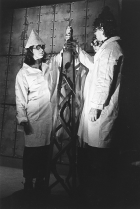 Figure 1. The beginnings of steel. |
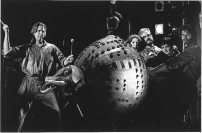
Figure 2. Pig iron, which is also used as a percussion instrument. |
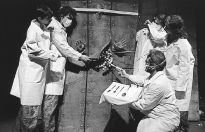 Figure 3. Studying the composition of steel. |
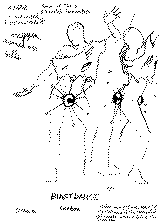 Figure 4. A design sketch by Steve O'Hearn of the costume for the seductive oxygen molecule in "Blastdance." |
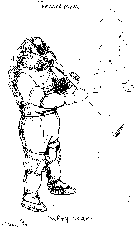 |
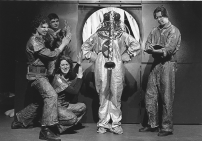 |
| Figure 5. (right) An early sketch configuration by Steve O'Hearn and (left) the realized safety suit worn by workers at the Squonk's Bessemer furnace. | |
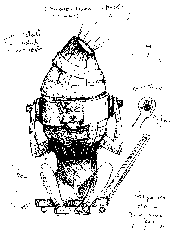 |
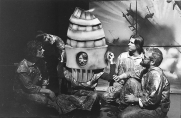 |
| Figure 6. (right) The conception of the man-sized pupped Bessie, the Bessemer furnace, and (left) the actual costume. | |
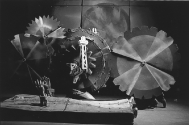 Figure 7. The forming machines. |
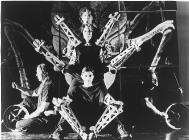 Figure 8. The hammer dance. |
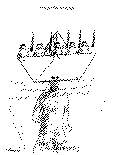 Figure 9. Steve O'Hearn's concept of the Homestead strike sequence. |
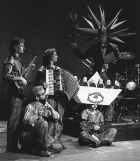 Figure 10. "Bring Us Your Huddled Masses." The Homestead strike prop in the foreground is the same as the design in Figure 9. |
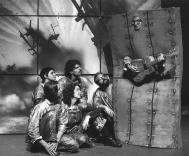 Figure 11. Old Man Steel delivers a lesson. |
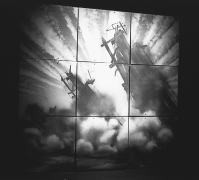 Figure 12. The closing image of the mill coming down. |
Direct questions about this or any other JOM page to jom@tms.org.
| Search | TMS Document Center | Subscriptions | Other Hypertext Articles | JOM | TMS OnLine |
|---|